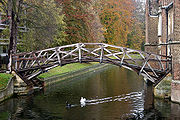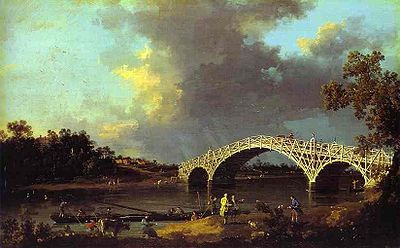
Old Walton Bridge
Encyclopedia

Walton Bridge
Walton Bridge is a road bridge across the River Thames in England, carrying the A244 road between Walton-on-Thames and Shepperton. It crosses the Thames on the reach between Sunbury Lock and Shepperton Lock. The architecture of the present bridge could at best be described as visually unappealing...
built across the River Thames
River Thames
The River Thames flows through southern England. It is the longest river entirely in England and the second longest in the United Kingdom. While it is best known because its lower reaches flow through central London, the river flows alongside several other towns and cities, including Oxford,...
at Walton-on-Thames
Walton-on-Thames
Walton-on-Thames is a town in the Elmbridge borough of Surrey in South East England. The town is located south west of Charing Cross and is between the towns of Weybridge and Molesey. It is situated on the River Thames between Sunbury Lock and Shepperton Lock.- History :The name "Walton" is...
in Surrey
Surrey
Surrey is a county in the South East of England and is one of the Home Counties. The county borders Greater London, Kent, East Sussex, West Sussex, Hampshire and Berkshire. The historic county town is Guildford. Surrey County Council sits at Kingston upon Thames, although this has been part of...
, England. The wooden bridge was completed in 1750 and stood until 1783 when it was dismantled to make way for a brickwork
Brickwork
Brickwork is masonry produced by a bricklayer, using bricks and mortar to build up brick structures such as walls. Brickwork is also used to finish corners, door, and window openings, etc...
replacement.
History
Construction of the bridge by a Mr White of WeybridgeWeybridge
Weybridge is a town in the Elmbridge district of Surrey in South East England. It is bounded to the north by the River Thames at the mouth of the River Wey, from which it gets its name...
was started in 1748 and was completed in 1750. The construction was paid for by Samuel Dicker
Samuel Dicker
Samuel Dicker , was an English politician who represented Plymouth in the British House of Commons in the eighteenth century, and was also responsible for the building of the first Walton Bridge in Surrey....
who was the MP
Member of Parliament
A Member of Parliament is a representative of the voters to a :parliament. In many countries with bicameral parliaments, the term applies specifically to members of the lower house, as upper houses often have a different title, such as senate, and thus also have different titles for its members,...
for Plymouth
Plymouth (UK Parliament constituency)
Plymouth was a parliamentary borough in Devon, which elected two Members of Parliament to the House of Commons in 1298 and again from 1442 until 1918, when the borough was merged with the neighbouring Devonport and the combined area divided into three single-member constituencies.-In the...
. By paying for its construction Dicker also obtained the right to collect tolls
Toll bridge
A toll bridge is a bridge over which traffic may pass upon payment of a toll, or fee.- History :The practice of collecting tolls on bridges probably harks back to the days of ferry crossings where people paid a fee to be ferried across stretches of water. As boats became impractical to carry large...
from users of the bridge. There were some objections to the construction of the bridge from the ferry
Ferry
A ferry is a form of transportation, usually a boat, but sometimes a ship, used to carry primarily passengers, and sometimes vehicles and cargo as well, across a body of water. Most ferries operate on regular, frequent, return services...
operators, who thought it would impact their livelihoods; the barge
Barge
A barge is a flat-bottomed boat, built mainly for river and canal transport of heavy goods. Some barges are not self-propelled and need to be towed by tugboats or pushed by towboats...
es who thought it would make the river unnavigable; and residents of Walton-on-Thames who were worried about an influx of undesirable elements from north of the river. Despite the opposition, Dicker pressed on with construction, probably motivated by his own desire for easy access to London and for the financial benefits the tolls would bring.

Mathematical Bridge
The Mathematical Bridge is the popular name of a wooden footbridge across the River Cam, between two parts of Queens' College, Cambridge. Its official name is simply the Wooden Bridge....
across the River Cam
River Cam
The River Cam is a tributary of the River Great Ouse in the east of England. The two rivers join to the south of Ely at Pope's Corner. The Great Ouse connects the Cam to England's canal system and to the North Sea at King's Lynn...
at Queens' College, Cambridge
Queens' College, Cambridge
Queens' College is a constituent college of the University of Cambridge, England.The college was founded in 1448 by Margaret of Anjou , and refounded in 1465 by Elizabeth Woodville...
and had been responsible for the construction of many of the timber centres of the Westminster Bridge while working as James King's foreman. First constructed between 1749 and 1750, this bridge still stands, although it has been rebuilt twice, most recently in 1905. The Old Walton Bridge was supported by four central stone piers connected by three arches built of wooden beams and joists. The span of the central arch was 130 feet (39 m), at the time the widest unsupported span in England (it was surpassed by William Edwards Bridge
Old Bridge, Pontypridd
The Old Bridge , which is now also known as the William Edwards Bridge or Pontypridd Bridge, was originally known as the New Bridge or Newbridge, it is an arched single-span footbridge that spans the River Taff at Pontypridd in Wales. The bridge was built by William Edwards and was completed in 1756...
at Pontypridd
Pontypridd
Pontypridd is both a community and a principal town of Rhondda Cynon Taf, Wales and is situated 12 miles/19 km north of the Welsh capital city of Cardiff...
). The other two main arches were each 44 feet (13 m), though Dicker later suggested that the design would have allowed for side spans of 70 ft or more. Away from the water there were five further small brickwork arches on each side of the river.
On the strength of their success with Walton Bridge Etheridge and Dicker put forward two proposals for a bridge at Blackfriars, one for building in stone and the other in timber. The stone-built proposal was accepted but several changes to Etheridge's design lead to him leaving the project before it was completed.
Although considered an impressive feat of engineering at the time of its construction, the bridge stood for only 33 years. Dicker died in London in 1760 and his estates in the area were sold. The bridge passed to his nephew, Michael Dicker Sanders, but he found it difficult to meet the costs of its upkeep. A report on the condition of the bridge in 1778 suggested that decay in the wooden frame made it unsuitable for use, and it was dismantled in 1783 to make way for a brickwork
Brickwork
Brickwork is masonry produced by a bricklayer, using bricks and mortar to build up brick structures such as walls. Brickwork is also used to finish corners, door, and window openings, etc...
bridge which was completed in 1788 and eventually collapsed in 1859.
Canaletto's paintings

Canaletto
Giovanni Antonio Canal better known as Canaletto , was a Venetian painter famous for his landscapes, or vedute, of Venice. He was also an important printmaker in etching.- Early career :...
spent time in England between 1746 and 1755, mostly in London, but at some time after 1750 he travelled out to Walton to produce a painting of the bridge. He had previously depicted one of Etherbridge's constructions in 1747 as the framing span of The City Seen Through an Arch of Westminster Bridge. Normally the figures populating his landscapes were anonymous, but his painting of the bridge is unusual because the identities of several of the figures are known. In the centre of the painting on the near bank, two figures can be seen standing together; to the left is Thomas Hollis
Thomas Hollis
Thomas Hollis was an English political philosopher and author.-Early life:Hollis was educated at Adams Grammar School until the age 10, and then in St. Albans until 15, before learning French, Dutch and accountancy in Amsterdam. After the death of his father in 1735, his guardian was a John...
who commissioned the painting from Canaletto, and almost certainly requested that he be included. It is likely that Hollis selected the image from a sketch in Canaletto's portfolio, as the painting omits the stone abutments that were added in 1751. To Hollis' right is Thomas Brand, his lifelong friend and heir. Further to the right, dressed in colourful livery
Livery
A livery is a uniform, insignia or symbol adorning, in a non-military context, a person, an object or a vehicle that denotes a relationship between the wearer of the livery and an individual or corporate body. Often, elements of the heraldry relating to the individual or corporate body feature in...
, is Hollis' servant, Francesco Giovannini, and at the feet of Hollis is his dog, Malta. Seated a little distance from the central group on the left (with a cow looking over his shoulder) is an artist thought to be Canaletto himself. In the river a ship is lowering its sail in order to pass under the bridge. With the towering storm clouds forming above the bridge, Canaletto contrasts the forces of nature with the work of engineering below; the painting is the only of his English works in which he attempts to capture the weather.
Samuel Dicker's house at Mount Felix can be seen in the rear of the picture to the left of the bridge, but Dicker — probably after seeing Hollis's painting — commissioned a different view of the bridge from Canaletto in 1755 in which his house can be seen more clearly and the full extent of the bridge works that he had funded (including the extensive stone abutments) is obvious.

